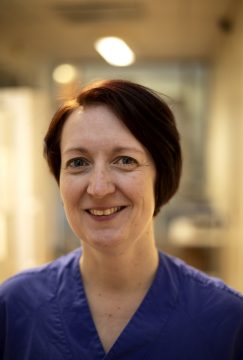COVID-19. Large quantities of SARS-Cov-2 virus have been grown in cell culture and are now available in a specially equipped laboratory at Microbiology. The cell-culture grown virus will be used to test if existing substances in 1500 already approved medicines may be effective against COVID-19. “I am hopeful that we will find something interesting,” explains Kristina Nyström, docent at Medical Microbiology.
The studies now starting at Microbiology will give medicine to patients that already have COVID-19 and do not involve a vaccine for preventing the illness.
“Many people have severe symptoms and are sick a long time,” explains Kristina Nyström. “Obviously, it would be incredibly valuable if we could find an active medicine that is already approved, even if for another illness, and that is available on the market. At the same time, research continues to develop entirely new substances, but this would be a shortcut for treatment of severely ill patients.”
The Public Health Agency of Sweden grew the coronavirus in cell cultures using samples from the first case discovered in Sweden, a woman in Jönköping. Large volumes of the virus have now been grown at Microbiology and are stored in a freezer at −80 °C.

“Recently we also received a library with over 1500 medicines, both antiviral and others, which we are about to start testing,” explains Kristina Nyström. “We will test them all but will likely write off the majority immediately. There are, however, a few candidates that seem interesting and that we hope to move forward with.”
Changes when infected
The virus will be tested on cells from green monkeys. These cells clearly show changes when infected. The experiments will be conducted in a special Biosafety Level 3 laboratory. This means that there are separate specific entrances for sample material and for staff, and the safety cabinets have air flows filtered in multiple stages. Staff must wear special protective clothing, face masks, gloves, and gowns that are disposed of immediately after use.
“First, we will ensure that the substance we are testing is not toxic, poisonous, to the cell. Then we will study, step by step, what the cell looks like without infection, with infection, without medication, and finally with medication at different concentrations. The substances that seem to have an effect will be studied in more detail, and, for example, to see if the medicine effects the cell at the beginning or the final stage of the infection.”
The researchers will also conduct other studies, like examining how much sugar is at the outer edge of the particle. This influences how the virus attaches to cells, which can provide clues for developing new medicines. Antibodies from individuals who have had the disease will also be studied.
“It is an advantage that the University of Gothenburg and the hospital collaborate so closely. This makes it easy to go between the lab and clinical research, benefiting both organizations.”
Kristina Nyström cannot say how long it might take to find already existing medicines that can be used to treat COVID-19 patients.
“More tests are needed. But I’m optimistic and don’t believe that it will take very long before we find a preparation that can be used clinically.”
Footnote: The Swedish Research Council has received an additional SEK 100 million in the government’s spring budget to support research on COVID-19. In addition to this government’s initiative, the Swedish Research Council will increase basic virus research by SEK 100 million over the period 2020–2024.
TEXT: EVA LUNDGREN / GU-JOURNALEN
PHOTO: JOHAN WINGBORG











